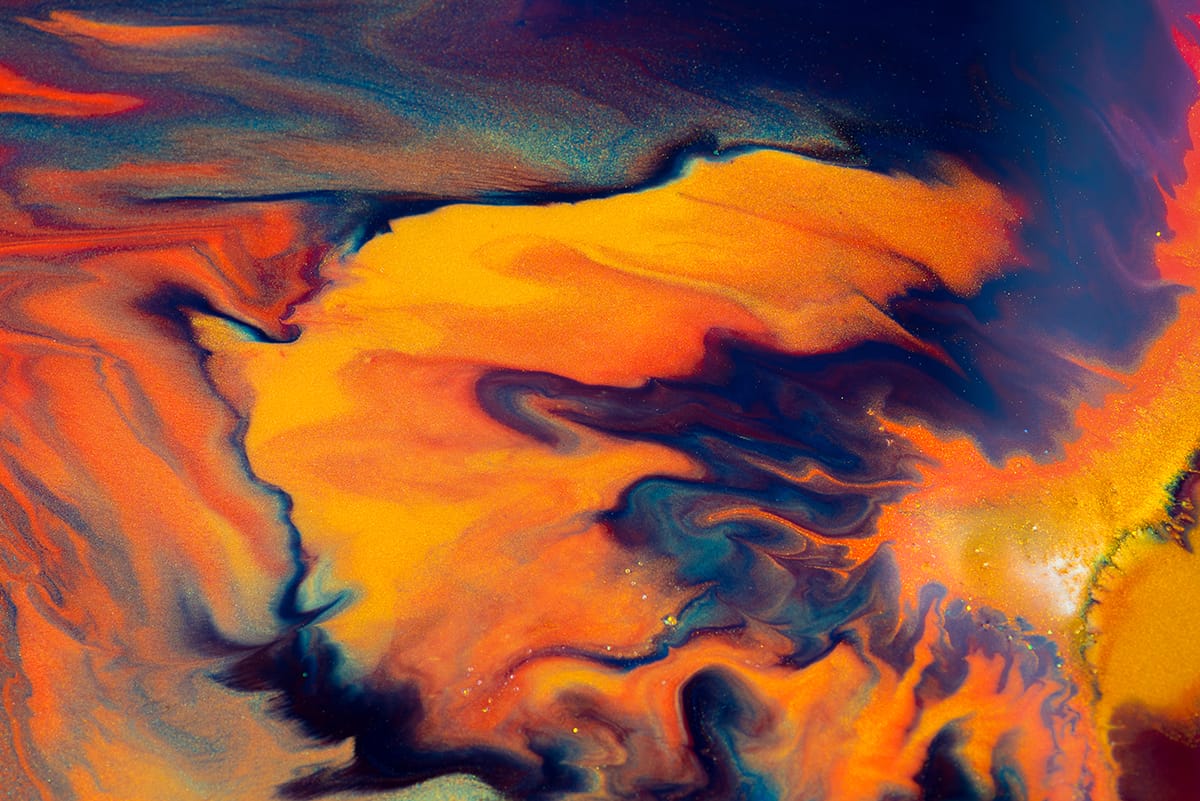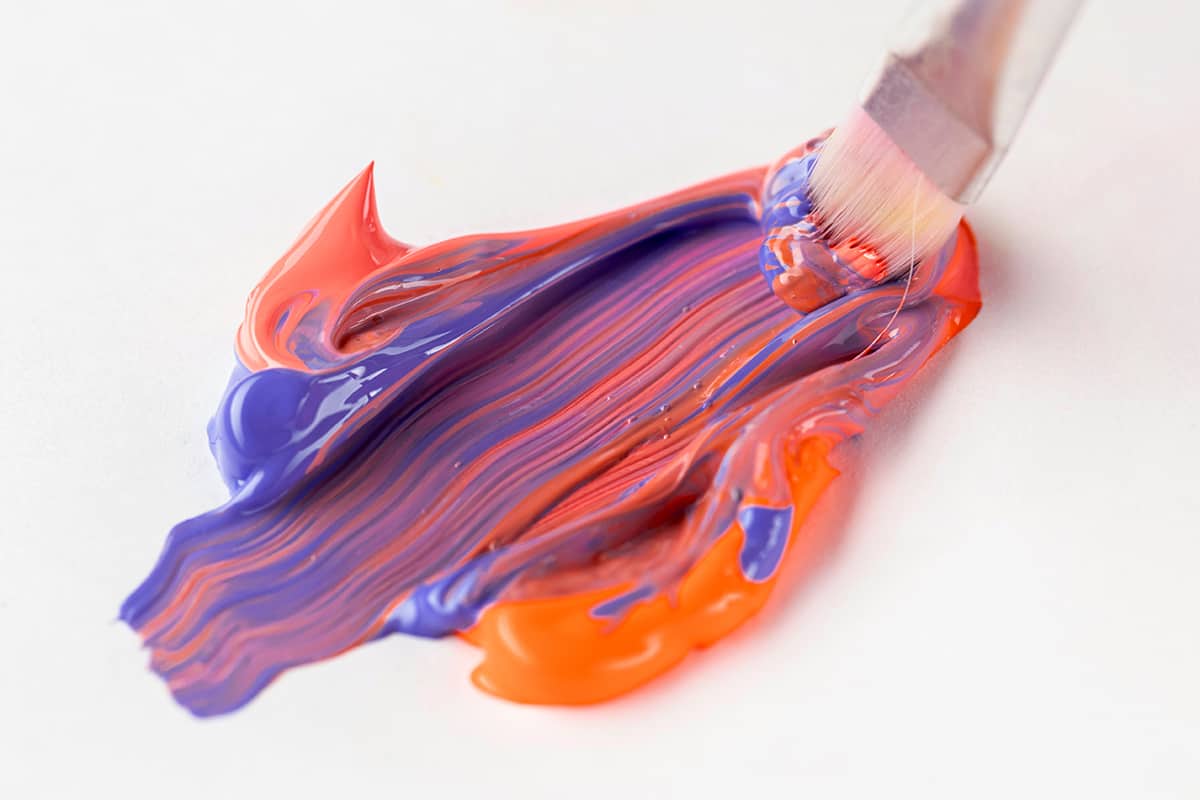Most people know the basic primary colors needed to create secondary colors, for example, red and yellow make orange, and blue and yellow make green. But mixing a secondary color with a primary color is many lesser-known combinations.
One of the reasons for this is that the resulting colors you get when mixing a secondary color with a primary color can be quite wide-ranging, depending on the shade of colors you start with and how much of each color you use.
Orange and blue mixed together can create versions of brown, green, and even purple. Here we look at the ways you can use orange and blue to achieve different shades and how to apply color theory to mixing colored paints.
What Colors Can Blue and Orange Make?
Blue and orange can be mixed together to create variations of brown, green, or purple. To understand why this is possible and how you can create one of these colors using just blue and orange, you first need to understand the basics of color theory.
Brown
To make brown, you need to mix the three primary colors together in equal proportions, The three primary colors are blue, red, and yellow, so when making brown, you would combine one part blue with one part red and one part yellow. However, since we know that red and yellow mixed together make orange, it makes sense that orange and blue will make brown because, essentially, it is the same as mixing red, yellow, and blue together.
The difference when mixing orange and blue, though, is the proportions of the primary colors in the mix. If orange is created with a mix of one part red and one part yellow, and the resulting orange is then mixed with blue at a ratio of one part orange to one part blue, this means the actual proportions mixed will be one part red, one part yellow, and two parts blue.
The resulting shade will be brown, but it will be a cool and dark brown, as opposed to a warm brown that would be achieved with a higher proportion of red and yellow. If you want to create a warm brown using orange and blue, you can do this by doubling the amount of orange used. To make the brown warmer still, continue adding orange until the desired effect is achieved.
Green
Green is created by mixing blue and yellow, and since orange is very close to yellow on the color wheel, mixing both blue and orange together can result in a shade of green. Since red is also prominent in any shade of orange, this will usually result in a mixture of orange and blue taking on a khaki or olive shade.
The green will have a warmer tone, thanks to the presence of yellow and red in the orange, which will make for a green that feels soothing and natural. If you want to make a green that has fewer warm tones, mix a small amount of orange with a greater amount of blue.
Purple
Purple is made by mixing blue and red. Since orange is made up of 50 percent red, mixing orange and blue together can result in a shade of purple. The fact that yellow will also be in the mix means that the resulting purple color will be quite murky. For a purple that is more vibrant, start with a darker shade of blue such as royal blue, and a bright shade of tangerine orange.
Gradually add the orange paint to the blue paint until the shade of purple you want starts to appear. If too much orange is added, the purple will start to take on a more brown hue.
Can You Mix Primary and Secondary Colors?
Primary and secondary colors can be mixed to create new colors, and having an understanding of what colors are involved in making the secondary colors will help you to predict what other colors will be formed. Since secondary colors contain two primary colors, mixing a secondary color with a primary color is effectively another way of mixing three primary colors, but in varying proportions.
For example, if you mix green with red, you are actually mixing blue and yellow with red because green is a secondary color made with a combination of blue and yellow. Mixing orange with blue is essentially mixing red and yellow with blue because orange is a secondary color made with a combination of red and yellow.
However, if you mix one part green with one part red, the color you achieve will be different from mixing one part orange with one part blue. This is because although the mixes only actually contain a combination of red, yellow, and blue, the fact that the proportions are different means the resulting colors will be different.
Green mixed with red will give you a shade of brown because the proportion of red in this mix will be greater than the proportion of yellow and blue. When orange is mixed with blue, the resulting color will be closer to murky green or purple because blue will be the dominant color in the mix.
Should Orange and Blue be Mixed?
Orange and blue are contrasting colors that sit directly opposite each other on the color wheel. This means they complement each other perfectly, and when used together in the same space, one color will make the other appear more vivid and vibrant. Due to their contrasting nature, orange and blue can be used together with great effect in home decor.
For a bold style, use pure blue and pure orange, but break this up with a third neutral color, such as white or gray. If you want to mix blue and orange in a color scheme but prefer a more subtle contrast, opt for navy blue with a pale peachy orange or a soft gray-blue with burnt orange.
If you have opted for an orange and blue color scheme and have some paint left over, you might be wondering what you can do to make use of this paint. It’s always a good idea to keep a small amount of leftover paint in your basement or garage for touch-ups.
If your walls suffer from a few scuffs that won’t wash off, or you need to fill and repaint some holes in the wall at a later date, then having a little remaining paint in the same color will be handy for touching up small areas, rather than having to buy more of the paint.
If you have more leftover paint than you will ever need for touch-ups, you can combine the blue and orange paint together to create a new color, which could be used for a feature wall or to upcycle some old wooden furniture. The color you will create will depend on the shades of blue and orange you started with and the amount of blue and orange you use.
The resulting color could be anywhere from olive green to brown or even purple. If you’re trying to achieve a specific color, always add the paint in small increments so it’s easy to adapt through the process.







